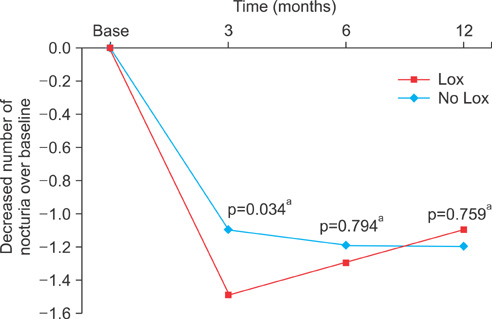Korean J Urol.
2011 Apr;52(4):265-268.
Long-Term Effect of Loxoprofen Sodium on Nocturia in Patients with Benign Prostatic Hyperplasia
- Affiliations
-
- 1Department of Urology, Keimyung University School of Medicine, Daegu, Korea. cikim@dsmc.or.kr
Abstract
- PURPOSE
We evaluated the long-term effects of loxoprofen on nocturia in patients with benign prostatic hyperplasia (BPH).
MATERIALS AND METHODS
Between January 2006 and December 2008, 40 BPH patients with 2 or more episodes of nocturia received an alpha-blocker, 5-alpha reductase inhibitor, and a single dose of 60 mg of loxoprofen at night before sleep for 12 months (Group I). During the same period, 38 BPH patients selected as the control group received an alpha-blocker and 5-alpha reductase inhibitor (Group II). Patients were reevaluated after 3, 6, and 12 months of treatment by the number of nocturia episodes and side effects.
RESULTS
After 3 months of treatment, the number of nocturia episodes decreased significantly compared with baseline in both group I and group II (1.9+/-0.7, 2.1+/-0.7, respectively, p<0.05). The degree of decrease in nocturia was significantly different between the groups (-1.5+/-0.9, -1.1+/-0.9, respectively, p=0.034). After 6 and 12 months, the number of nocturia episodes decreased significantly compared with baseline in both group I and group II (p<0.05), but the degree of decrease was not significantly different between the groups (p>0.05). After 6 and 12 months of treatment in group I, treatment-emergent adverse events, including 5 cases of gastric discomfort (12.5%), 3 cases of leg edema (7.5%), and 1 case of decreased urine volume (2.5%), occurred in 9 of the 40 (22.5%) patients.
CONCLUSIONS
Loxoprofen can be an effective treatment for patients with nocturia secondary to BPH in the short term. Long-term use of loxoprofen is not recommended because of the side effects.
Keyword
MeSH Terms
Figure
Reference
-
1. Middelkoop HA, Smilde-van den Doel DA, Neven AK, Kamphuisen HA, Springer CP. Subjective sleep characteristics of 1,485 males and females aged 50-93: effects of sex and age, and factors related to self-evaluated quality of sleep. J Gerontol A Biol Sci Med Sci. 1996. 51:M108–M115.2. Asplund R, Aberg H. Health of the elderly with regard to sleep and nocturnal micturition. Scand J Prim Health Care. 1992. 10:98–104.3. Johnson TM 2nd, Jones K, Williford WO, Kutner MH, Issa MM, Lepor H. Changes in nocturia from medical treatment of benign prostatic hyperplasia: secondary analysis of the Department of Veterans Affairs Cooperative Study Trial. J Urol. 2003. 170:145–148.4. Bruskewitz RC, Larsen EH, Madsen PO, Dørflinger T. 3-year followup of urinary symptoms after transurethral resection of the prostate. J Urol. 1986. 136:613–615.5. Wasson JH, Reda DJ, Bruskewitz RC, Elinson J, Keller AM, Henderson WG. The Veterans Affairs Cooperative Study Group on Transurethral Resection of the Prostate. A comparison of transurethral surgery with watchful waiting for moderate symptoms of benign prostatic hyperplasia. N Engl J Med. 1995. 332:75–79.6. Matsuda K, Tanaka Y, Ushiyama S, Ohnishi K, Yamazaki M. Inhibition of prostaglandin synthesis by sodium 2-[4-(2-oxocyclopentylmethyl) phenyl] propionate dihydrate (CS-600), a new anti-inflammatory drugs, and its active metabolite in vitro and in vivo. Biochem Pharmacol. 1984. 33:2473–2478.7. Sugimoto M, Kojima T, Asami M, Iizuka Y, Matsuda K. Inhibition of prostaglandin production in the inflammatory tissue by loxoprofen-Na, an anti-inflammatory prodrug. Biochem Pharmacol. 1991. 42:2363–2368.8. Okada S, Watanabe H, Kojima Y, Yanai Y, Sasaki S, Kohri K. Loxoprofen sodium treatment for elderly men with refractory nocturia: effect on night-time urine production. Int J Urol. 2008. 15:462–464.9. Saito M, Kawatani M, Kinoshita Y, Satoh K, Miyagawa I. Effectiveness of an anti-inflammatory drug, loxoprofen, for patients with nocturia. Int J Urol. 2005. 12:779–782.10. Chang HS, Kim BK, Sohn JC, Park CH, Kim CI. Effectiveness of loxoprofen sodium on nocturia in patients with benign prostatic hyperplasia. Korean J Urol. 2007. 48:195–198.11. Araki T, Yokoyama T, Kumon H. Effectiveness of a nonsteroidal anti-inflammatory drug for nocturia on patients with benign prostatic hyperplasia: a prospective non-randomized study of loxoprofen sodium 60 mg once daily before sleeping. Acta Med Okayama. 2004. 58:45–49.12. Lee JG. Pathophysiology of male lower urinary tract symptoms. Korean J Urol. 2005. 46:887–896.13. Presti JC Jr. Indomethacin and symptomatic relief of benign prostatic hyperplasia. JAMA. 1995. 273:347.14. Maggi CA. Prostanoids as local modulators of reflex micturition. Pharmacol Res. 1992. 25:13–20.15. Wen SF. Nephrotoxicities of nonsteroidal anti-inflammatory drugs. J Formos Med Assoc. 1997. 96:157–171.16. Abrams PH, Feneley RC. The actions of prostaglandins on the smooth muscle of the human urinary tract in vitro. Br J Urol. 1975. 47:909–915.17. Andersson KE, Ek A, Persson CG. Effects of prostaglandins on the isolated human bladder and urethra. Acta Physiol Scand. 1977. 100:165–171.18. Andersson KE. Treatment of overactive bladder: other drug mechanisms. Urology. 2000. 55:5A Suppl. 51–57.19. Palea S, Toson G, Pietra C, Trist DG, Artibani W, Romano O, et al. Pharmacological characterization of thromboxane and prostanoid receptors in human isolated urinary bladder. Br J Pharmacol. 1998. 124:865–872.20. Urade Y, Hayaishi O. Prostaglandin D2 and sleep regulation. Biochim Biophys Acta. 1999. 1436:606–615.21. Yoshida Y, Matsumura H, Nakajima T, Mandai M, Urakami T, Kuroda K, et al. Prostaglandin E (EP) receptor subtypes and sleep: promotion by EP4 and inhibition by EP1/EP2. Neuroreport. 2000. 11:2127–2131.22. Waikakul S, Waikakul W. A post marketing survey on the side-effects of loxoprofen. J Med Assoc Thai. 1999. 82:721–726.
- Full Text Links
- Actions
-
Cited
- CITED
-
- Close
- Share
- Similar articles
-
- Effectiveness of Loxoprofen Sodium on Nocturia in Patients with Benign Prostatic Hyperplasia
- The Effect of alpha-Blocker Treatment for Nocturia with Benign Prostatic Hyperplasia
- Post Treatment Change of Nocturia in Patients with Benign Prostatic Hyperplasia
- Study on Persistent Nocturia after Treatment of Benign Prostatic Hyperplasia and Effectiveness of Desmopressin in Persistent Nocturia with Nocturnal Polyuria
- The Effect of Tolterodine and Oxybutyninin on Nocturia in Patients with Benign Prostatic Hyperplasia


